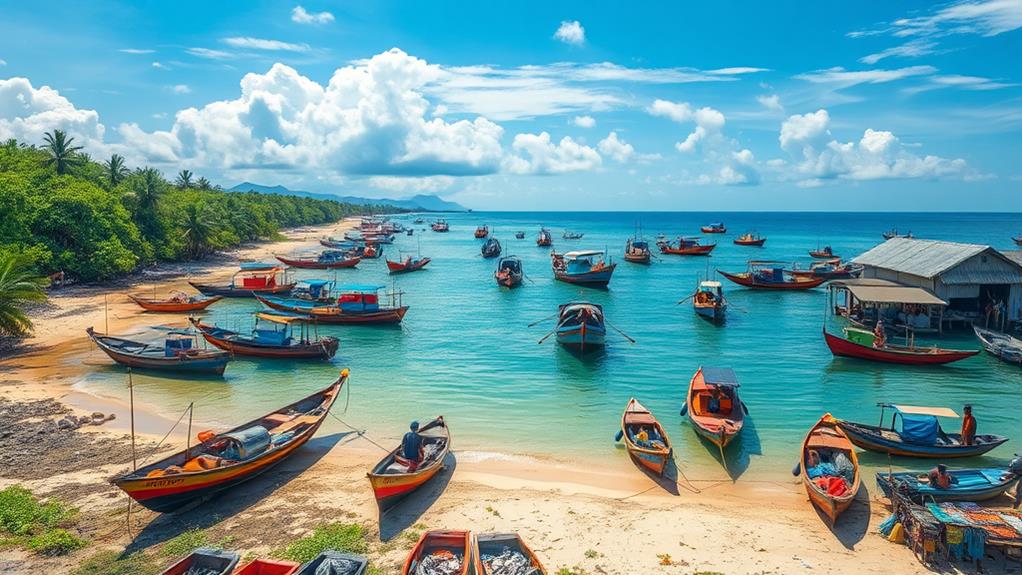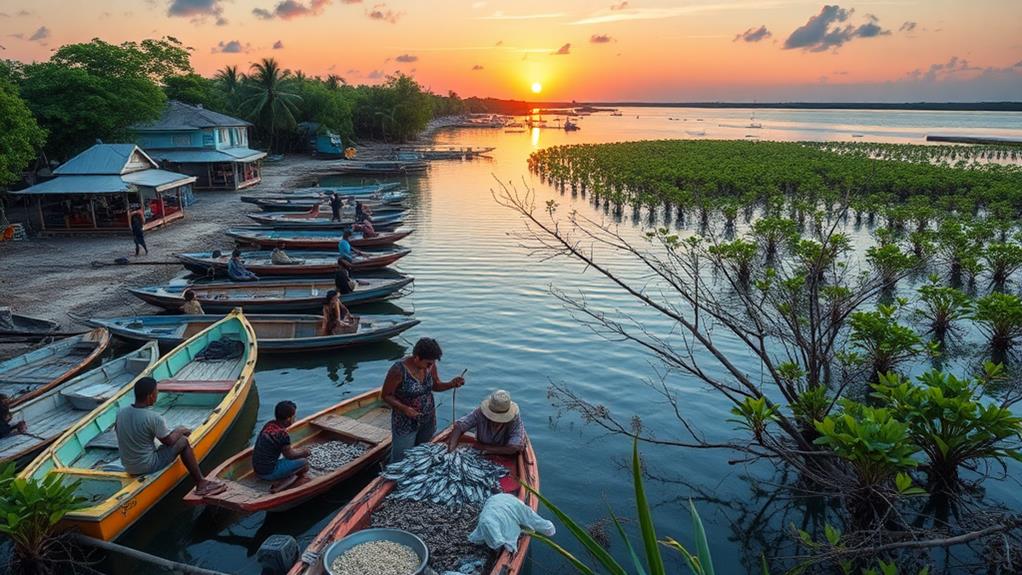Sustainable fisheries are essential for food security and livelihoods in the Philippines. Many people rely on fishing for protein, with small-scale fisheries providing 80-95% of local catches.
These fisheries create over 4 million jobs and are important for local economies. However, problems like overfishing and climate change endanger these fish populations.
To solve these issues, effective management strategies can help increase fish numbers and ensure they are available for the future.
Involving communities in sustainable fishing practices builds resilience against environmental challenges and enhances economic benefits.
Understanding these factors shows that maintaining sustainable fisheries is crucial for your health and prosperity.
Overview of Fisheries in the Philippines

The fishing industry in the Philippines is crucial to the economy and supports millions of jobs. Over 4 million people work in fisheries, which includes capture fishing and aquaculture. This sector affects around 20 million jobs when you consider processing and distribution.
Small-scale fisheries account for 80-95% of the local fish catch, making them essential for food security and the livelihoods of many families in both rural and urban areas.
In the Philippines, the average fish consumption is 36 kg per person each year, which is much higher than the global average of 13 kg. This shows how important fish is as a protein source.
Coastal communities rely on healthy marine ecosystems for fishing, while inland fisheries are important for food security, especially in rural regions. However, these resources face challenges like environmental degradation.
To keep fisheries sustainable, it's important to balance economic needs with ecological health. This way, we can support jobs and protect marine ecosystems for the future.
Economic Significance of Fisheries
Fisheries in the Philippines play a major role in the economy by providing jobs for about 1.37 million operators. This industry is essential for food security, with people consuming an average of 21.0 kg of fish per person each year. Managing marine resources sustainably is important to keep this balance.
The key contributions of fisheries include:
- Employment: More than 20 million people work in fisheries-related jobs, which helps the economy stay strong.
- Foreign Exchange Earnings: The Philippines is a leading fish exporter in Southeast Asia, which boosts national income.
- Food Security: Fisheries supply vital protein sources necessary for the health of the population.
The impact of fisheries goes beyond direct jobs; it also affects industries like processing, distribution, and trade. Supporting sustainable fishing practices is essential to ensure that these resources last, providing jobs and food for future generations in the Philippines.
Protecting marine resources is crucial for the economic well-being of the country.
Employment Opportunities in Fishing

Sustainable fisheries are important because they support food security and provide economic stability.
In the Philippines, more than 4 million people work in fishing, which helps the local economy and food supply. About 60% of these workers are involved in marine capture, while the other 40% work in inland capture and aquaculture.
These fishing communities succeed because sustainable practices increase fish populations, ensuring they can continue their work.
Additionally, the fishing industry helps create 20 million jobs in related areas like processing, distribution, and trade. This shows how crucial the fishing sector is for the local economy.
Sustainability Challenges in Fisheries
Fisheries in the Philippines face serious problems that threaten both the ocean environment and local jobs. Overfishing has caused many fish species to become scarce, putting food security at risk for coastal communities. Harmful fishing methods and habitat destruction have damaged marine ecosystems, leading to a loss of biodiversity. This makes it harder to manage fisheries effectively.
Key challenges include:
- Climate Change: Changes in weather patterns disrupt fish migration and spawning, which puts even more pressure on already struggling fish populations. For example, warmer sea temperatures can push fish to deeper, cooler waters.
- Small-Scale Fisheries Vulnerability: Small-scale fisheries catch 80-95% of local fish. These fisheries are particularly affected by poor management, resulting in the depletion of fish stocks and threatening the jobs of about 1.37 million fishermen.
- Post-Harvest Losses: Poor handling and processing of fish lead to significant waste, which decreases profits and increases food insecurity in rural areas. For instance, if fish aren't stored properly, they can spoil quickly.
These challenges highlight the urgent need for effective strategies to manage fisheries.
Addressing these issues is vital to ensure that fisheries continue to provide food and income for millions of Filipinos. It's also essential for the health of marine ecosystems and the survival of coastal communities.
Effective Management Strategies

To protect fish stocks and marine ecosystems in the Philippines, effective management strategies are essential. These strategies help ensure sustainable fisheries, which are important for food security and coastal resilience. One key approach is the Ecosystem Approach to Fisheries (EAF), which focuses on preserving marine biodiversity while keeping fish populations healthy. This balance is vital for both the environment and people's well-being.
Community-based management has shown significant success. For example, it has resulted in a 24% increase in fish biomass and a 12% economic benefit for local fishing communities. This proves that when stakeholders are involved, the outcomes are better. Additionally, capacity building for local governments and fishing communities is crucial. It equips them to face issues like resource depletion and climate change.
Here's a summary of the effective management strategies:
| Strategy | Impact |
|---|---|
| Ecosystem Approach to Fisheries | Enhances marine biodiversity and sustainability |
| Community-based Management | Increases fish biomass and economic benefits |
| Capacity Building | Strengthens local governance and resilience |
Role of Aquaculture in Food Security
Aquaculture is essential for food security in the Philippines, especially as wild fish populations decrease.
It provides over 25% of the country's total fish supply, which is important for local diets and nutrition.
About 1.5 million people rely on aquaculture for their livelihoods. This industry produces approximately 2 million metric tons of fish each year, helping to replace the fish that are becoming harder to find in the wild.
Aquaculture also promotes healthier ecosystems. By using sustainable farming methods, it helps protect marine life and improve biodiversity.
Since the 1970s, aquaculture has grown significantly, focusing on high-value species such as tilapia, shrimp, and milkfish.
This growth not only ensures a steady supply of fish but also strengthens communities against climate change.
How Does Sustainable Fisheries Contribute to Food Security in the Philippines Compared to the Rice Industry?
Sustainable fisheries in the Philippines play a crucial role in maintaining food security by providing a steady supply of nutritious seafood. Compared to the Philippine rice industry feeding nation, sustainable fisheries offer a diverse source of protein, reducing the reliance on rice and improving overall food security in the country.
Community Engagement in Sustainable Practices

Community engagement in sustainable fishing practices is essential for improving both the environment and the economy in the Philippines. Involving fishing communities in decision-making helps create responsible fishing practices that lead to positive results. For example, community efforts have resulted in a 24% increase in fish biomass and a 12% increase in economic benefits.
The table below shows important parts of community engagement in sustainable fishing:
| Aspect | Impact |
|---|---|
| Participatory Governance | Sets rules for fishing gear and licenses |
| Education & Awareness Programs | Helps communities learn responsible fishing |
| Small-Scale Fisheries | Provides 80-95% of local fish catch, aiding food security |
| Resilience Against Climate Change | Builds strong community ties and supports the environment |
These actions not only help ensure food security for coastal families but also make communities stronger against climate change. When communities are involved, they feel a sense of ownership, which is vital for managing fisheries sustainably. By following these practices, fishing communities can protect their livelihoods and the health of their ecosystems.
Policy Recommendations for Sustainability
Effective community engagement is crucial for creating strong policy recommendations that improve sustainability in fisheries in the Philippines. To make sure that sustainable fisheries support food security and the livelihoods of coastal communities, a comprehensive approach to governance and management is necessary.
Implement the Ecosystem Approach to Fisheries (EAF): This method helps keep fish stocks healthy and protects marine biodiversity. For example, by using EAF, fishing practices can be adjusted to avoid harming other marine life and habitats.
Enhance capacity-building initiatives: Training local government units is essential for better fisheries management. This training should focus on preserving biodiversity. For instance, local officials can learn how to monitor fish populations and enforce regulations that protect endangered species.
Develop education and communication programs: It's important to raise awareness about sustainable fishing practices. Community programs can teach residents the benefits of conservation, leading to a stronger commitment to protecting marine resources. For example, workshops can help fishermen understand how overfishing affects their future catches.
Questions and Answers
How Is the Importance of Fisheries Production in the Philippines?
Fisheries production is very important for fishing communities in the Philippines. It helps support local economies and provides food for families. Good fisheries policies and rules are necessary to protect fish populations and the environment. For example, by managing fishing areas and promoting sustainable practices, communities can maintain healthy fish stocks. This ensures that future generations will also have access to fish.
What Is the Relationship Between Food Security and Sustainable Fishing?
Sustainable fishing is important for food security because it helps keep fish populations stable and supports healthy ocean ecosystems. For example, when fish are caught responsibly, there are more fish available for people to eat. This ensures that communities can rely on fish as a source of nutrition. Additionally, sustainable fishing practices can lead to economic stability for local fishermen and their families. When fish stocks are managed well, it also helps to protect the environment from the negative effects of climate change. Overall, sustainable fishing practices are essential for ensuring a steady food supply and a healthy planet.
Why Are Sustainable Fisheries Important?
Sustainable fisheries are crucial for maintaining marine biodiversity and a balanced ecosystem. These fisheries help protect fish populations and their habitats, which supports various species and the overall health of the ocean. For example, sustainable fishing practices prevent overfishing, allowing fish communities to thrive and reproduce.
Sustainable fisheries also benefit the economy of fishing communities. When fish populations are healthy, fishermen can catch enough fish to support their families and local businesses. For instance, communities that follow sustainable practices often see more stable fish stocks and better long-term income.
Policies, education, and technology are vital in promoting sustainable fishing. Effective policies can limit how much fish can be caught and protect certain areas from fishing. Educational programs teach fishermen about sustainable methods, such as using nets that allow young fish to escape. Additionally, technology, like fish tracking systems, helps monitor fish populations and reduces bycatch.
Responsible consumption is essential in supporting sustainable fisheries. When consumers choose sustainably sourced seafood, they encourage fishing practices that protect the environment. For example, buying fish certified by organizations like the Marine Stewardship Council supports fisheries that follow sustainable guidelines.
Lastly, sustainable fisheries help build resilience against climate change. Healthy fish populations and ecosystems can better withstand changes in the environment, such as rising ocean temperatures. For example, resilient coral reefs can support more diverse marine life, contributing to a stable fishing industry.
What Are the Main Challenges Facing the Sustainability of Fisheries and Aquaculture in the Philippines?
The main challenges facing the sustainability of fisheries and aquaculture in the Philippines include overfishing, habitat destruction, illegal fishing, pollution, and climate change. Overfishing reduces fish populations, making it hard for them to recover. For example, many areas have seen a decline in popular fish like tuna and sardines. Habitat destruction occurs when coastal areas are damaged, affecting fish breeding grounds. Illegal fishing practices, such as using explosives, further harm marine life.
Pollution from waste and chemicals also impacts water quality, harming fish and their habitats. Additionally, climate change leads to rising sea temperatures and ocean acidification, which can disrupt marine ecosystems.
Weak fishery regulations make it difficult to manage these issues effectively. For instance, many fishing areas lack proper monitoring, allowing overfishing to continue. Economic pressures on local communities can lead to unsustainable fishing practices, threatening biodiversity.
To overcome these challenges, community involvement is essential. Engaging local fishermen in sustainable practices can help protect fish stocks. Improved aquaculture practices, such as using sustainable feed and better management techniques, can also support fish populations.